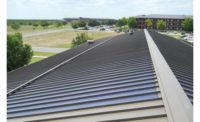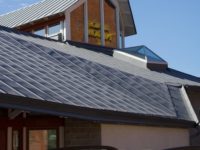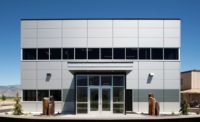When considering the impact the building and construction industry has on the environment in terms of energy consumed, greenhouse gases emitted, and waste generated, the numbers can seem staggering. In fact, the building and construction sector is responsible for 30 percent of total global final energy consumption and 27 percent of total energy sector greenhouse gas emissions, according to the International Energy Agency. As these numbers continue to rise each year, architects and building professionals have committed to prioritizing more sustainable building envelope practices, including adherence to the Living Building Challenge, LEED certifications, the 2030 Challenge, and more.
Within these sustainability programs, more weight is being placed on material and building system selection. When considering which materials and building systems will contribute to energy savings and emissions reductions, many architects and building professionals are looking to metal roofing systems. Although the roof and its materials were once touted as the least energy efficient component of a building, metal roofs are garnering a different reputation.
Inherent in their makeup, metal roofs are sustainable, durable, and last about three times longer than other roofs. They help to trap less heat and cool a building down quicker. These qualities of a metal roof become invaluable as designers and builders are faced with the task of improving the energy performance of commercial buildings without losing out on a visually appealing design.
Choosing the Right System for an Efficient Build
A big percentage of building and construction industry-generated energy is spent on the manufacturing and transporting of assemblies, so specifying a material and system that is sustainable before, during and after installation is key. Metal roofing achieves all three. They are made from up to 60 percent recycled material, are lightweight allowing for a more efficient shipping and installation process and are themselves recyclable after their extended lifetime. These properties greatly reduce waste, avoid landfilling materials, and lower the energy needed to routinely replace metal coils and panels.
When it comes to material weight, metal panels are on average 50-75 percent lighter than other roofing materials like concrete tile or cement shakes. The metal roofing components are able to be efficiently packed and safely shipped with fewer truckloads, requiring less fuel and emissions to ship, translating to a smaller carbon footprint. This equates to reduced energy spend from the manufacturing plant to the transportation process to the jobsite. In addition, many contractors are using portable roll-forming machines to manufacture the metal into panels directly on site. This process reduces lead times and creates less waste for a more efficient and sustainable build.
When it comes to the end of a metal roof’s life, the fully recyclable metal components can be donated to installers for scrap credit. This circular economy plays a crucial part in helping reduce the billions of pounds of waste generated in the U.S. each year, contributing to a more sustainable building industry. As architects and designers play their part in the global goal towards net zero emissions, specifying an assembly that supports an environmentally-friendly building envelope becomes invaluable.
Endurance for the Long-Haul
Although a metal roof is 100 percent recyclable, its long lifespan means it won’t need to be replaced very often. Due to the durable properties of metal, a metal roof will not crack, shrink, warp, or deteriorate from weather-related events. They are capable of withstanding 120-mph winds, shed heavy snow loads quickly, and can achieve the highest rating of impact testing standards, making hail or wind-blown debris no match for a metal roof. And with annual destructive wildfire seasons becoming increasingly common, metal roofs are ideal as they help prevent the spread of flames since metal doesn’t burn like most other roofing materials. This unmatched endurance results in a long lifespan of 40-60 years, which equates to not just money saved in repairs and replacements, but energy saved that would ordinarily be consumed to make, distribute and install a roof every 12-20 years.
What’s more, the durability of a metal roof makes it an ideal application for solar panels. The metal panels can interlock with standing seams which means the clips don’t have to penetrate and damage the roofing deck. The solar panels then do their job, absorbing sunlight and converting it into electrical energy, resulting in lower energy bills and reduced dependence on fossil fuels.
Leading metal roofing manufacturers take the enduring qualities of a metal roof one step further by applying a resilient paint finish. When a metal roof is finished with a high-performance coating like polyvinylidene fluoride (PVDF), the coating helps resist weather, fading, chalking and UV damage. All of these contributing factors equate to an extended life span, and as pressures rise to prioritize energy conservation wherever possible, specifying a system that is built to last is critical.
Trapping Heat for a Cooler Roof
Finally, metal roofing systems take energy-efficiency to the next level with cool coating technology, or cool rated roofing. A cool rated roof refers to painted metal roofs that use reflective pigments to absorb less sunlight, or solar energy, to reduce the amount of heat transferred into a building. Contrary to what one might imagine, these cool rated roofs don’t have to just be painted white. There are many cool roof rated colors, which use darker colored pigments that are highly reflective in the near infrared portion of the solar spectrum. Many of these colors can reflect and re-emit solar radiation by up to 90 percent.
Specifically, during the warmer months, a cool roof contributes to a more energy efficient building by reducing heat gained from the sun, which keeps the building cooler during the day. This results in more comfortable interior temperatures, less strain on air conditioning systems during the hottest parts of the day, and reduced energy costs. These metal roofing systems also help a building cool quicker when the sun sets, which equates over time to a smaller carbon footprint.
Additionally, these cool roofs can help neighboring buildings use less energy by reducing the urban heat island effect. Because a cool roof does not heat up as much as standard roofs, they can reduce the higher-than-average heat in cities generated from paving, roofing and other heat absorbing materials. In turn, this helps the surrounding buildings work more efficiently as well. In this manner, architects and building professionals can lead the way towards a more efficient building envelope when they employ metal roofing systems.
Designed for Longevity, Beauty and Efficiency
As an environmentally-friendly, durable, long-lasting system that also intuitively absorbs heat, metal roofing systems are proving there is another way as they work to support a building industry focused on reducing greenhouse gas emissions and conserving energy. Their ability to regulate a building’s temperature and increase its renewable energy make it the ultimate system to support an energy efficient building envelope.
Few assemblies combine functional advantages with sustainability and a visually appealing aesthetic more than a metal roof. These fully customizable systems allow for enhanced design versatility that is not easily accomplished with other roofing materials. Architects can achieve their design goals with curved patterns, one-of-a-kind cornices, and a virtually limitless rainbow of cool rated colors while supporting a more energy efficient building envelope. With the vast benefits of metal roofing becoming more common knowledge, designers and roofing professionals are well-equipped and positioned to play a critical role in decarbonizing the built environment.



